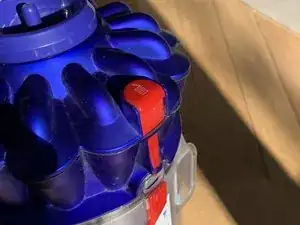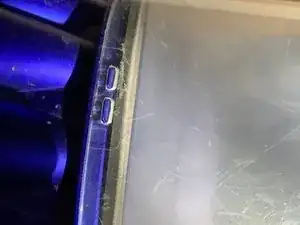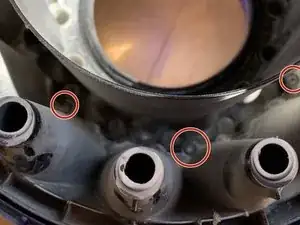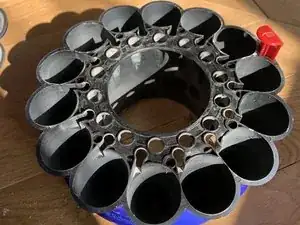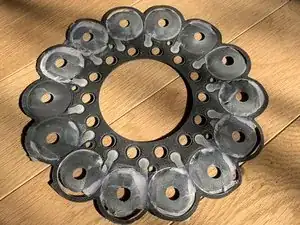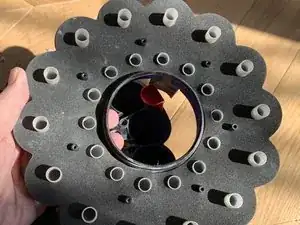Introduction
How to replace the gasket at the top of the cyclone block of a Dyson DC37 Allergy. This tutorial should apply to the entire DC37 range and is probably valid for Dysons of similar architecture (such as the DC 33).
This tutorial will show you how to easily disassemble and reassemble the cyclone block. Provide a cloth in addition to the torx screwdriver to clean these hard-to-reach parts
Tools
-
-
Remove the Cyclone block from the rest of the vacuum cleaner (grey button on the motor)
-
Position the tank above a trash can or bag (open) then press the red button to release the bottom of the tank and empty the contents
-
Also remember to remove the fine dust filter which is simply inserted in the center of the cyclone block. It can be cleaned under the tap (see care instructions)
-
-
-
You will then separate the cyclone block from the dust tank
-
As can be seen in the first photo, the red slide that controls the bottom of the tank masks a small grey button
-
The second photo shows the fixing fangs (opposite side of the button) that solidify the cyclone block with the tank
-
A press of the grey button detaches the transparent tank from the coloured cyclone block.
-
-
-
A little rag on the outside of the cyclone block will be welcome before attacking it
-
Equipped with your torx screwdriver (star), you will be able to remove the 7 (seven) screws that attach the low skirt to the upper body
-
-
-
Set aside the seal that is attached to the lower part of the body and clean the
-
The lower part can be cleaned with a cloth and or water. It is possible to remove the skirt by sliding a thin tool to clear the hook notches, but this is not our goal today.
-
The body is now clearly visible and a new rag is needed in order to continue
-
-
-
You will now remove the cradle that houses the dust filter. This one is simply nested in the top block
-
It is necessary to gently unclip each of the 14 rings that enclose the cyclone exits
-
Once this operation is done, it is enough to remove the cone by pulling it to extract it from the interlocking
-
You can clean the cone as well as the inside of the top of the cyclone block
-
-
-
You must unscrew the last 7 screws using the Torx screwdriver
-
These are visible at the bottom of the block, between the extraction cones. It is likely that this part is very dusty and that you had to scratch a little to find them
-
-
-
Once the screws are removed, you can easily separate the cap from the intermediate block
-
A little cleaning is necessary
-
-
-
You will have to gently remove the joint so as not to tear it during the operation, especially if it is damaged
-
The cap is cut into 4 parts: the lid, 2 white pieces, one with moveable guides and the seal
-
Over time, movements and vibrations of moving parts have chipped and cut the seal
-
-
-
We see here the state of wear after fifteen years of good and loyal service
-
It is possible to make a temporary repair with adhesive tape to bouche and collect the pieces
-
Be careful not to obstruct the passages of screws or tubes.
-
The best solution is to buy a new one. They can be found on eBay for about ten euros.
-
You can see my repair here to wait for the spare part to arrive
-
-
-
All that remains is to reassemble with the new or repaired seal.
-
Don't forget to put the tank seal back on
-
That's it, good repair
-
To reassemble your device, follow the instructions in reverse order.
5 comments
bonjour Peut on avoir la ref du joint pour un dc37 Merci
DJ Olive -
Salut, qu'entendez-vous par joint, pouvez-vous expliquer un aliotle plus pour que je puisse vous aider, merci :-)
Je n'ai pas de référence Dyson. La pièce d'origine est introuvable. Mais il s'agit juste d'une feuille de mousse de caoutchouc coupée à la bonne forme, il y a de nombreux vendeurs de pièces compatibles. Une recherche de 'joint cyclone DC37', ou 'joint d'étanchéité DC37' remontent des vendeurs. On peut aussi chercher en anglais: 'DC37 Gasket' ou 'DC37 Cyclon Gasket' devrait donner de bon résultat.
Bonjour,
Pouvez vous donner la taille du tournevis Torx nécessaire, SVP ?
Merci par avance
Il s'agit d'un T8 (il est indiqué dans l'en tête). La taille est normalement indiquée sur le tournevis, ou la tête dans le cas de tête interchangeable.


